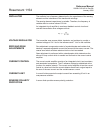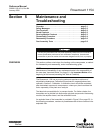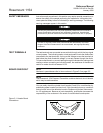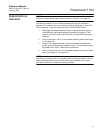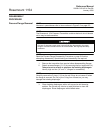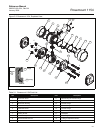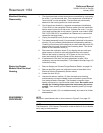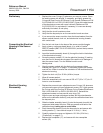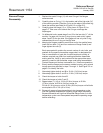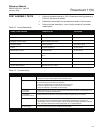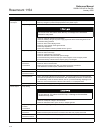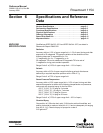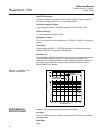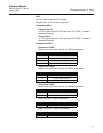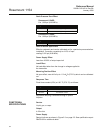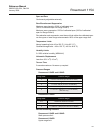
Reference Manual
00809-0100-4514, Rev BA
January 2008
Rosemount 1154
5-8
Process Flange
Reassembly
1. Replace the metal O-rings (11) with new O-rings if the flanges
were removed.
2. Carefully place an O-ring (11) in the isolator well of the high side (“H”)
of the sensing module. Place the O-ring so the edge of the rolled ring
faces the module (see Detail A of Figure 5-2 on page 5-5).
3. Carefully place the flange (13 or 15) as shown in Figure 5-2 on
page 5-5. Take care not to disturb the O-rings or damage the
diaphragms.
4. On differential units, repeat steps 2 and 3 for the low side (“L”) of the
module. If a gage unit has two O-rings (one on each side), repeat
steps 2 and 3 for the low side. If the gage unit has only one O-ring,
reassemble with one O-ring on the high side.
5. Keeping the flanges parallel to each other and to the module faces,
insert the four bolts (14) (and four washers on Range Code 9) and
finger-tighten the nuts (8).
Each spare parts kit contains the correct number of nuts, bolts, and
washers for the specific transmitter range code it is designated for.
Due to consolidation of parts kits, the bolt length and quantity of
washers required may differ from existing transmitter assemblies
and/or parts kits. Verify by part number that the appropriate spare
parts kit is used for the transmitter range code being re-assembled.
Contact Rosemount Nuclear Instruments, Inc. if there are questions.
6. Evenly seat the flanges on the sensor module housing, using a hand
torque wrench as specified in steps 7 through 11. See Figure 5-2 on
page 5-5 to identify the bolts.
7. Alternately tighten bolts A and B to 10 ft-lb (13.6 N-m) torque.
8. Alternately tighten bolts C and D to 10 ft-lb (13.6 N-m) torque.
9. Check the torque on bolts A and B.
10. Check the torque on bolts C and D.
11. Repeat steps (7)-(10) at 15 ft-lb (20 N-m) torque, at 20 ft-lb
(27 N-m) torque, at 25 ft-lb (34 N-m) torque, at
30 ft-lb (41 N-m) torque, and at 35 ft-lb (48 N-m) torque until all bolts
are torqued to 35 ±1 ft-lb (48 ±1 N-m).
12. Expose all ranges of gage transmitters to two temperature cycles
over the expected temperature operating range before calibrating.
Expose differential and high-line differential Range Code 4’s to two
temperature cycles over the expected temperature operating range
before calibrating.



